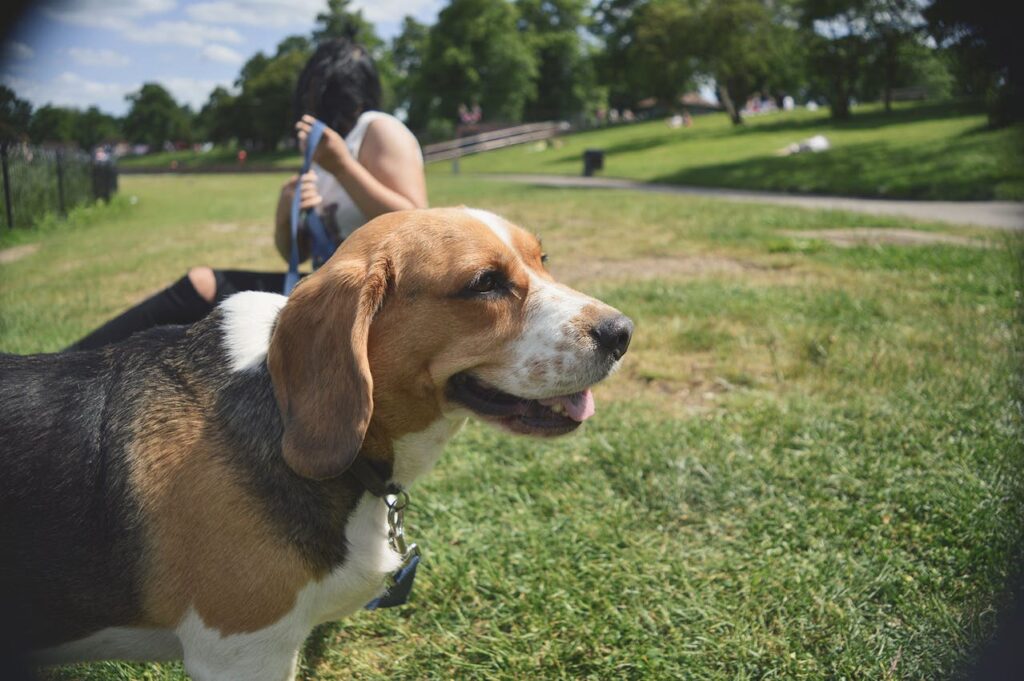7 Biggest Mistakes Beagle Owners Make (And How to Avoid Them)
Beagles. Those adorable floppy ears, soulful eyes, and a wagging tail that just doesn’t stop. But, as much as we love them, Beagles can be a handful!
Owning one of these little hounds requires some know-how.
If you’re a Beagle parent (or thinking about becoming one), let’s talk about the seven biggest mistakes people make—and how you can avoid them. Ready?
1. Not Understanding Their Energy Levels

Beagles may be small, but don’t let that fool you—they’re high-energy dogs. If you think your Beagle is content lounging around all day, you’re in for a surprise. These pups need a lot of exercise to stay happy and healthy. If they don’t get it, prepare for some indoor zoomies and chewed-up furniture.
Solution: Take them on daily walks (long ones!), play fetch, or even set up a little agility course in the backyard. A tired Beagle is a happy Beagle, trust me.
🍲 50 Printable Dog Food Recipes Your Pup Will Love
Skip the fillers and preservatives. Make healthy, homemade meals your dog will actually eat — using everyday ingredients you already trust. Vet-friendly, budget-friendly, and super easy to follow. 🐾
Perfect for picky eaters, senior dogs, and pups with sensitive stomachs. Make mealtime simple and nutritious again.
Get the Recipes Now 🐶2. Ignoring Their Incredible Sense of Smell

Beagles have an insane sense of smell, and they’re known to follow it without thinking twice. You know that cute Beagle nose? Yeah, it’s going to lead them into trouble if you’re not careful. One minute they’re sniffing the grass, and the next they’re halfway down the street chasing a scent.
Solution: Make sure your yard is securely fenced, and always use a leash during walks. Beagles can’t help it—they’re nose-driven explorers. Keeping them safe is your job!
3. Underestimating Their Stubbornness

If you’ve ever tried training a Beagle, you know they have a stubborn streak a mile long. You tell them to “sit,” and they look at you like, “I’ll do it when I’m good and ready.” Beagles are independent thinkers, which makes training a bit more challenging.
Solution: Be consistent and patient. Use positive reinforcement—treats and praise work wonders. And remember, Beagles are food-motivated, so use that to your advantage!
4. Not Socializing Them Early Enough

Beagles are naturally friendly, but that doesn’t mean you can skip socialization. Without early socialization, Beagles can become overly excitable or nervous around new people, dogs, or situations. And trust me, you don’t want a 20-pound ball of excitement dragging you down the street every time they see a new dog.
Solution: Expose your Beagle to different environments, sounds, people, and animals from a young age. Puppy classes, trips to the dog park, and even just walking in busy areas can help.
5. Overfeeding Them (Because, Let’s Be Real, They Love to Eat)

Beagles are food hounds—literally. They’ll eat anything, anywhere, anytime. It’s super easy to overfeed them because they’re always begging for more. But here’s the thing: Beagles are prone to weight gain, and an overweight Beagle is an unhealthy Beagle.
Solution: Stick to a regular feeding schedule and measure their portions carefully. Treats are fine, but keep them in check. And no, they don’t need a snack every time they give you those big, sad eyes (I know, it’s tough to resist).
6. Not Providing Enough Mental Stimulation

Beagles are smart—sometimes a little too smart. If they get bored, they’ll find their own entertainment, and you might not like it. Without enough mental stimulation, Beagles can become destructive (hello, chewed-up shoes and shredded pillows).
Solution: Keep their brains busy with puzzle toys, training sessions, or even scent games (since they love sniffing!). A mentally stimulated Beagle is a well-behaved Beagle.
7. Thinking Their Howling Is Just “Cute”

Sure, that Beagle howl is adorable—at first. But when your pup starts howling at 3 a.m. because they heard a squirrel outside, it’s a different story. Beagles are vocal, and if left unchecked, their howling can drive you (and your neighbors) nuts.
Solution: Teach them a “quiet” command early on. Beagles can be trained to stop howling on command, but it takes consistency. Also, ensure they’re not howling out of boredom or lack of exercise.
FAQs
Q: Are Beagles hard to train?
A: Beagles are smart but stubborn, which can make training tricky. They respond well to positive reinforcement, especially when treats are involved. Just be patient, consistent, and prepared for a few challenges along the way.
Q: How much exercise does a Beagle need?
A: Beagles need at least an hour of exercise each day. They’re active dogs that love to walk, run, and sniff around. If they don’t get enough exercise, they can become destructive at home (not fun).
Q: Do Beagles really howl a lot?
A: Yes, Beagles are known for their howling. It’s part of their hound heritage. While it can be cute, it’s important to train them to be quiet on command, especially if they live in an area where neighbors are nearby.
Q: Are Beagles good with kids?
A: Absolutely! Beagles are friendly and gentle with kids, making them great family pets. Just make sure your Beagle is properly socialized and that the kids understand how to interact respectfully with the dog.
Q: How do I keep my Beagle from running away?
A: Beagles are natural explorers, and their noses often lead them into trouble. Make sure your yard is securely fenced, always use a leash on walks, and train them with recall commands (though even a well-trained Beagle might get distracted by an interesting scent!).
Final Thoughts
Owning a Beagle is a joy, but it’s not without its challenges. These little hounds are full of energy, curiosity, and a whole lot of personality. By understanding their unique needs—whether it’s exercise, mental stimulation, or the right training techniques—you can avoid common pitfalls and raise a happy, well-behaved Beagle.
Remember, they’re smart and stubborn, but with patience and love, your Beagle will become the perfect companion. And let’s be real, even when they’re being a bit mischievous, those floppy ears and big brown eyes make it all worth it, right? 🐾

I’ve spent 10+ years in dog training, digging into what makes dogs (and their humans) tick. At Smart Dog Learning, I share my no-nonsense, fun approach to training so you can enjoy life with a well-behaved, happy pup—no boring lectures, just practical results 😉





